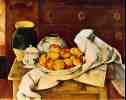![]()
 Still Life
Still Life
1883-87 (140 Kb); Oil on canvas, 25 5/8 x 31 7/8 in; Fogg Art Museum, Harvard University
Compared to the earlier still lifes, this magnificent painting is an advance, both in clarity and subtlety. It is still like the early style in the dark background; but although deep shadow has been almost eliminated, the contrast of light and dark is even more pronounced in the broad opposition of the foreground objects and the bureau. It is hard to imagine a simpler, more direct arrangement: the objects on the table closely crowded together, with the fruit in the center; the table and bureau, in the most obvious frontal position. Cézanne's will to stability, closure, and compactness is very evident here. It appears also in the color in the centering of the most intense tones--the mottled reds and yellows of the apples--between the broadly symmetrical masses of the green jug and greenish white peak of the tablecloth, and, in depth, between the great masses of darker red and yellow in the bureau and table, with which they form sonorous chords.
In the forms--a corresponding balance of curves and straight lines. The straight forms enclose the curves, they are outside them, but are also harmonized with them through the rectangularity of the groupings or symmetries of the curves. Some of the rounded objects--the jug at the left, the large platter--are finely flattened to approach the rectilinear. The big tablecloth, the most living object, is a complex world of straight and curved.
In this stable rectangular composition, the tablecloth is a powerful contrast and an element of disorder; we are surprised by its complexity, its alien character among the compact objects of single axis on the table, although it is assimilated to these through its colors and the tilting of the distorted platter. It is like a mountain, a rocky creviced mass, or like some human figure, twisting and turning, with an inner balance of directions. Each bend, fold, and tone is strategically considered in relation to neighboring shapes and colors. Without this fantastic body of cloth, the picture would be tame and empty, though still harmonious in color.
The painting has many fascinating refinements of drawing and composition. It is instructive to observe Cézanne's scruple in giving to each detail a unique form adapted to the adjoining objects and its place in the whole. To consider a minute example: the dark vertical keyhole of the bureau is opposed to the horizontal ellipse of the open jar which is in precise line with the lower knob. The keyhole plate and the two knobs at the right are flattened at the sides vertically, and we see that this relates them to the horizontal flattening of the ellipses of the jars. These are aligned with the lower knob and the horizontal band of the bureau. The axial contrast of the knobs and ellipses is an expression of the dominant contrast of vertical and horizontal in the bureau, the table, the wall, and floor. The musicality and perfection of this canvas overwhelm us. Wonderfully constructed, minutely considered, full of patterns yet without a prior governing pattern, precise yet unexpected in detail, it is rich in variation like life itself.